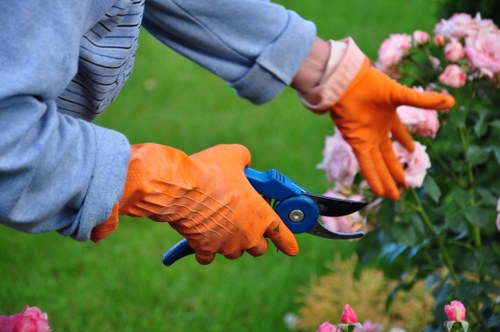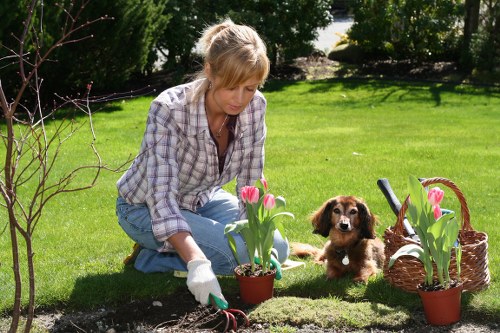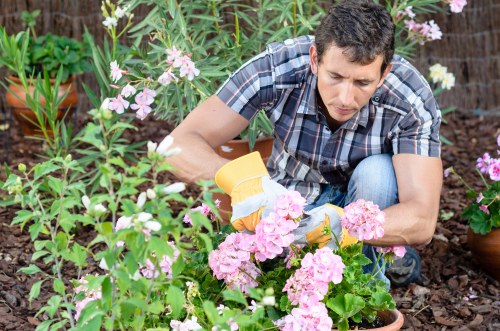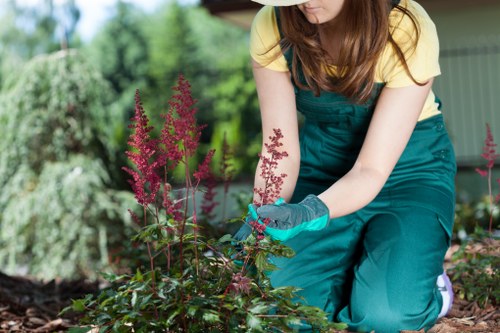Gardeners Woodlands: A Comprehensive Guide

Welcome to the enchanting world of Gardeners Woodlands. Nestled amidst nature, this woodland area offers a serene escape for gardening enthusiasts and nature lovers alike. Whether you're an experienced gardener or just starting, Gardeners Woodlands provides the perfect environment to cultivate your green thumb.
The Woodlands boast a diverse range of flora and fauna, making it a haven for biodiversity. From towering trees to vibrant wildflowers, the area is a testament to nature's splendor. The rich soil and favorable climate conditions further enhance its appeal, allowing gardeners to grow a variety of plants successfully.
One of the standout features of Gardeners Woodlands is its well-maintained trails. These paths wind through the forest, offering picturesque views and easy access to different gardening zones. Whether you're looking to plant a tranquil garden nook or a bustling herb garden, the Woodlands cater to all gardening aspirations.

The History of Gardeners Woodlands
The history of Gardeners Woodlands is as rich and vibrant as the plants that grow within its boundaries. Established in the early 20th century, the Woodlands were initially used for timber and resource management. However, over time, the area transformed into a beloved spot for gardening and leisure, thanks to dedicated community efforts.
In the 1950s, local gardeners championed the cause to preserve the Woodlands, ensuring that the space remained a green sanctuary for future generations. Their efforts led to the creation of several community gardens and educational programs aimed at promoting sustainable gardening practices.
Today, Gardeners Woodlands stands as a testament to the power of community and the enduring love for gardening. It continues to evolve, incorporating modern gardening techniques while preserving its natural charm.

Flora and Fauna of Gardeners Woodlands
The biodiversity in Gardeners Woodlands is truly remarkable. The area is home to a wide variety of plants, including native trees, shrubs, and flowering plants. Popular species include oak, maple, and birch trees, which provide shade and habitat for numerous animals.
In addition to trees, the Woodlands feature an array of flowering plants such as wild roses, daisies, and lilies. These plants not only add beauty to the landscape but also attract pollinators like bees and butterflies, essential for a healthy ecosystem.
Fauna in the Woodlands includes a diverse range of wildlife. Gardeners and visitors may encounter deer, foxes, and a variety of bird species. The presence of these animals indicates a thriving ecosystem, where plants and wildlife coexist harmoniously.

Gardening Opportunities in Woodlands
Gardeners Woodlands offers numerous opportunities for both novice and experienced gardeners. The area is divided into different zones, each tailored to specific gardening needs. Whether you're interested in flower gardening, vegetable cultivation, or creating a natural habitat, there's a space for you.
The community gardens are particularly popular, providing plots for individuals to cultivate their plants. These gardens foster a sense of community, allowing gardeners to share tips, resources, and harvests. Additionally, the Woodlands host seasonal events and workshops to help gardeners enhance their skills.
For those interested in sustainable gardening, the Woodlands offer resources and support. Composting areas, rainwater harvesting systems, and organic gardening practices are encouraged, promoting an eco-friendly approach to gardening.

Maintaining Your Garden in Woodlands
Maintaining a garden in Gardeners Woodlands requires a combination of knowledge and passion. The unique environment presents both opportunities and challenges that gardeners must navigate. Understanding the local climate, soil types, and plant species is essential for successful gardening.
Regular maintenance tasks such as watering, weeding, and pruning are necessary to keep gardens healthy and thriving. Gardeners should also be mindful of the local wildlife, ensuring that plants are protected from pests and diseases in a sustainable manner.
Joining the local gardening community can provide valuable support and resources. Shared knowledge and collaborative efforts can lead to more beautiful and productive gardens, enhancing the overall beauty of Gardeners Woodlands.
Local Gardening Clubs
Joining a local gardening club can greatly enhance your gardening experience in Gardeners Woodlands. These clubs offer a platform for gardeners to share experiences, exchange tips, and participate in community projects.
- The Woodlands Garden Society: Focuses on traditional gardening techniques and hosts monthly meetings.
- Eco Gardeners of Woodlands: Emphasizes sustainable and organic gardening practices.
- The Herb Enthusiasts: Specializes in the cultivation and use of herbs for culinary and medicinal purposes.
Participating in these clubs can provide you with valuable insights and foster a sense of community among fellow gardeners.
Educational Programs and Workshops
Gardeners Woodlands offers a variety of educational programs and workshops designed to cater to gardeners of all skill levels. These programs aim to educate individuals on best gardening practices, sustainable techniques, and plant care.
- Introduction to Organic Gardening: Learn the basics of growing plants without synthetic fertilizers or pesticides.
- Advanced Pruning Techniques: Enhance your pruning skills to maintain plant health and aesthetics.
- Rainwater Harvesting Workshop: Discover how to collect and utilize rainwater for your garden.
These workshops not only provide practical knowledge but also encourage gardeners to adopt environmentally friendly practices.
Seasonal Gardening Tips
Gardening in Gardeners Woodlands varies with the seasons. Each season brings its own set of tasks and opportunities to enhance your garden.
- Spring: Ideal for planting new flowers and vegetables. Focus on soil preparation and planting early crops.
- Summer: Maintain moisture levels and protect plants from excessive heat. Regular weeding and harvesting are crucial.
- Autumn: Prepare your garden for winter by pruning and planting cover crops. Leaf composting can enrich the soil.
- Winter: Focus on planning for the next season. Protect sensitive plants and practice garden maintenance.
Adapting your gardening practices to the changing seasons ensures a thriving and resilient garden year-round.
Sustainable Gardening Practices
Embracing sustainable gardening practices in Gardeners Woodlands helps preserve the natural environment and promotes long-term garden health.
Key sustainable practices include:
- Composting: Recycling organic waste into nutrient-rich compost enhances soil fertility.
- Rainwater Harvesting: Collecting rainwater reduces reliance on municipal water sources and conserves water.
- Organic Pest Control: Using natural methods to deter pests minimizes chemical usage and protects beneficial insects.
- Diverse Planting: Planting a variety of species supports biodiversity and reduces vulnerability to pests and diseases.
Implementing these practices contributes to a healthier garden and a more sustainable community.
Community Events
Gardeners Woodlands hosts a range of community events that bring gardeners together to celebrate their shared passion.
- Spring Planting Festival: A day dedicated to planting new flowers and trees, featuring workshops and guest speakers.
- Harvest Fair: Celebrates the season's harvest with local produce, gardening displays, and hands-on activities.
- Winter Garden Walk: An evening event showcasing the beauty of gardens during the winter months, complete with guided tours.
These events provide opportunities for learning, networking, and enjoying the beauty of Gardeners Woodlands together.
Nearby Areas to Gardeners Woodlands
Gardeners Woodlands is surrounded by several charming areas, each offering unique features that complement the gardening experience.
- Pine Grove: Located just 2 miles east, Pine Grove is known for its extensive pine forests and peaceful walking trails.
- Maple Heights: Situated 3 miles north, Maple Heights boasts vibrant autumn foliage and community gardening spaces.
- Oakridge Park: 4 miles southwest, Oakridge Park features large oak trees and a popular bird-watching area.
- Willow Creek: Located 5 miles west, Willow Creek offers scenic water views and aquatic plant habitats.
- Elmwood Gardens: 6 miles southeast, Elmwood Gardens is renowned for its beautifully landscaped public gardens.
- Cedar Valley: 7 miles northeast, Cedar Valley provides fertile grounds for larger-scale gardening projects.
- Birchwood Lane: Situated 8 miles south, Birchwood Lane is a residential area with private community gardens.
- Spruce Hill: 9 miles northwest, Spruce Hill is famous for its timber and woodworking workshops.
- Fern Hollow: Located 10 miles east, Fern Hollow offers shaded areas perfect for shade-loving plants.
- Linden Meadows: 11 miles southwest, Linden Meadows features open fields ideal for vegetable gardens and orchards.
- Cherry Blossom Park: 12 miles north, Cherry Blossom Park is celebrated for its stunning cherry trees and spring blossoms.
- Redwood Terrace: 13 miles west, Redwood Terrace is home to some of the tallest trees and serene picnic spots.
- Magnolia Springs: 14 miles southeast, Magnolia Springs is known for its fragrant magnolia flowers and compact gardens.
- Cypress Point: 15 miles northwest, Cypress Point offers unique cypress trees and tranquil walking paths.
These nearby areas provide additional opportunities for exploration, relaxation, and gardening, enriching the overall experience of Gardeners Woodlands.
Getting Involved in the Community
Becoming an active member of the Gardeners Woodlands community can enhance your gardening journey. Here are ways to get involved:
- Volunteer Programs: Participate in community garden maintenance, tree planting, and conservation projects.
- Workshops and Seminars: Attend educational sessions to learn new gardening techniques and sustainable practices.
- Community Projects: Join collaborative projects such as creating butterfly gardens or establishing composting systems.
- Social Events: Engage in social gatherings like potlucks, garden tours, and seasonal festivals to build connections.
Active participation fosters a supportive environment, where gardeners can learn from each other and contribute to the Woodlands' beauty.
Challenges Faced by Gardeners Woodlands
Despite its many advantages, Gardeners Woodlands faces several challenges that require ongoing attention and solutions.
Environmental Impact: Increased foot traffic can lead to soil erosion and disturbance of local wildlife habitats. Implementing sustainable practices and promoting responsible gardening can mitigate these effects.
Invasive Species: The presence of invasive plant species threatens the native biodiversity. Regular monitoring and removal efforts are essential to maintain the ecological balance.
Climate Change: Changing weather patterns affect plant growth and garden sustainability. Adaptation strategies such as selecting climate-resilient plants and improving water management are necessary.
Future Plans for Gardeners Woodlands
The future of Gardeners Woodlands is bright, with several initiatives aimed at enhancing its appeal and sustainability.
Expansion of Garden Zones: Plans are underway to create additional gardening zones, including a dedicated herb garden and a butterfly sanctuary.
Renewable Energy Integration: Introducing solar-powered lighting and water pumps to promote eco-friendly energy use within the Woodlands.
Educational Outreach: Expanding educational programs to reach more community members and promote sustainable gardening practices.
Enhanced Community Facilities: Building more benches, picnic areas, and informational kiosks to improve visitor experience.
Conclusion
Gardeners Woodlands is a cherished sanctuary for gardeners and nature enthusiasts. Its rich biodiversity, community-oriented spaces, and commitment to sustainability make it a unique and valuable asset. By participating in community activities, adopting sustainable practices, and supporting conservation efforts, gardeners can contribute to the ongoing success and beauty of Gardeners Woodlands.
Whether you're looking to cultivate your own garden, learn new gardening techniques, or simply enjoy the natural beauty, Gardeners Woodlands offers something for everyone. Embrace the opportunities it presents and become a part of this thriving gardening community.
Frequently Asked Questions
1. What types of plants grow best in Gardeners Woodlands?
Gardeners Woodlands supports a wide variety of plants, including native trees like oak and maple, flowering plants such as wild roses and daisies, and vegetables in community gardens. The rich soil and favorable climate allow for diverse plant cultivation.
2. How can I get involved in the Gardeners Woodlands community?
You can get involved by joining local gardening clubs, volunteering for community projects, attending workshops, and participating in community events. Engaging with the community fosters collaboration and shared learning.
3. Are there any resources available for sustainable gardening practices?
Yes, Gardeners Woodlands offers resources such as composting areas, rainwater harvesting systems, and educational workshops on organic gardening and pest control. These resources support sustainable and eco-friendly gardening.
4. What are the membership benefits for Gardeners Woodlands?
Membership benefits include access to community gardens, participation in exclusive workshops and events, discounts on gardening supplies, and the opportunity to collaborate with fellow gardeners in maintaining and enhancing the Woodlands.
5. How do seasonal changes affect gardening in the Woodlands?
Each season presents unique opportunities and challenges. Spring is ideal for planting, summer for maintenance, autumn for preparation, and winter for planning. Adapting your gardening practices to the seasons ensures a healthy and thriving garden throughout the year.
